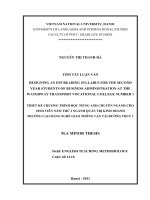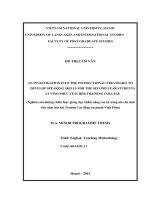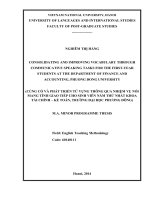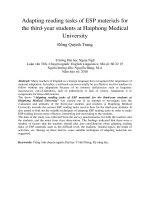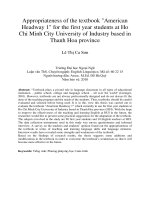Suggestions for writing formal business letters effectively for the 2nd year students
Bạn đang xem bản rút gọn của tài liệu. Xem và tải ngay bản đầy đủ của tài liệu tại đây (7.98 MB, 60 trang )
HANOI OPEN UNIVERSITY
FACULTY OF ENGLISH
--------------------
CODE: 14
GRADUATION THESIS
B.A DEGREE IN ENGLISH STUDY
SUGGESTIONS FOR WRITING FORMAL/BUSINESS
LETTERS EFFECTIVELY FOR THE 2ND-YEAR STUDENTS
Supervisor
: Le Thi Vy, M.A
Student
: Hoang Thi Luong Hoa
Date of birth
: 10.01.1994
Course
: K19A03 (2012-2016)
Hanoi – 2016
Graduation Paper
DECLARATION
Title:SUGGESTIONS FOR WRITING FORMAL/BUSINESS LETTERS
EFFECTIVELY FOR THE 2ND-YEAR STUDENTS
I certify that no part of the above report has been copied or reproduced by me
from any others’ work without acknowledgements and that the report is
originally written by me under strict guidance of my supervisor.
Hanoi, 15 April, 2016
Student
Signature
Supervisor
Signature
Full name
Full name
Hoang Thi Luong Hoa – K19A03 – (2012 – 2016)
Graduation Paper
ACKNOWLEDGEMENTS
At this stage of research accomplishment, I would like to express my
profound gratitude to my supervisor M.A Le ThiVy for the useful comments,
remarks and guidance through the learning process of this graduation thesis.
Furthermore, I would like to thank all teachers at the Faculty of English of
Hanoi Open University for the great and interesting lectures which give me a
sound basis with useful knowledge for the fulfillment of this graduation
thesis.
Moreover, special thanks are given to my parents and all of my friends for all
the material as well as moral support during my graduation thesis writing
period.
Hanoi, 15 April, 2016
Hoang Thi Luong Hoa
Hoang Thi Luong Hoa – K19A03 – (2012 – 2016)
Graduation Paper
TABLE OF CONTENTS
DECLARATION
ACKNOWLEDGEMENTS
TABLE OF CONTENTS
PART A: INTRODUCTION ....................................................................... 1
1. Rationale .................................................................................................. 1
2. Aims and objectives of the study .............................................................. 1
3. Scope of the study .................................................................................... 1
4. Research questions ................................................................................... 2
5. Methods of the study ................................................................................ 2
6. Design of the study .................................................................................. 2
PART B: DEVELOPMENT ........................................................................ 4
CHAPTER I: THEORETICAL BACKGROUND ..................................... 4
1.1
An overview of letters ......................................................................... 4
1.1.1. Definition and history of letter .......................................................... 4
1.1.2. Formal/Business Letter Definition ................................................... 5
1.1.3. The importance of formal/business letters ........................................ 5
1.2. Formal/Business letter format ............................................................ 6
1.2.1. Parts of a complete formal/business letter ........................................ 7
1.2.1.1. Sender’s address ............................................................................. 9
1.2.1.2. Date ................................................................................................ 9
1.2.1.3. Reference line ............................................................................... 10
1.2.1.4. Recipient’s address ....................................................................... 10
1.2.1.5. Attention line................................................................................. 11
1.2.1.6. Salutation ...................................................................................... 11
Hoang Thi Luong Hoa – K19A03 – (2012 – 2016)
Graduation Paper
1.2.1.7. Subject line ................................................................................... 11
1.2.1.8. Body.............................................................................................. 12
1.2.1.9. Complimentary close..................................................................... 12
1.2.1.10. Signature....................................................................................... 13
1.2.1.11. Enclosure ...................................................................................... 13
1.2.2. Margin and line spacing ................................................................. 13
1.2.3. Formal/Business letter layout ......................................................... 14
1.2.3.1. Block:............................................................................................ 14
1.2.3.2. Modified block:. ............................................................................ 16
1.3. American and British Formal/Business letter comparison ............. 17
1.4. Popular formal/business letters ........................................................ 18
1.4.1. The order letters .............................................................................. 18
1.4.2. The inquiry letters ........................................................................... 19
1.4.3. The complaint letters ....................................................................... 20
1.4.4. The adjustment letters ..................................................................... 21
1.4.5. The refusal letters............................................................................ 22
1.4.6. The resignation letters..................................................................... 22
1.4.7. The sales letters ............................................................................... 23
1.5. Summary ........................................................................................... 24
CHAPTER II. THE ANALYSIS OF SOME COMMON MISTAKES
MADE BSTUDENTS IN WRITING FORMAL/BUSINESS LETTER IN
BRITISH STYLE ....................................................................................... 25
2.1. Format mistakes .................................................................................. 36
2.2. Planning mistakes ................................................................................ 38
2.3. Language mistakes .............................................................................. 39
2.4. Summary .............................................................................................. 44
Hoang Thi Luong Hoa – K19A03 – (2012 – 2016)
Graduation Paper
CHAPTER
III.
SUGGESTIONS
FOR
WRITING
A
FORMAL/BUSINESS LETTER EFFECTIVELY .................................. 45
3.1. Suggestions ........................................................................................... 45
3.2. Summary .............................................................................................. 50
PART C: CONCLUSION .......................................................................... 51
REFERENCES
Hoang Thi Luong Hoa – K19A03 – (2012 – 2016)
PART A: INTRODUCTION
1.
Rationale
English is a universal language. People from different nations learn English
and consider it as a medium for them to communicate. There is no doubt that
English is exactly the most popular language in the world. In addition,
English is the language of communication between the people from different
cultures. Moreover, English is the language of science and technology.Thanks
to the popularity of English, most of the schools, colleges, universities
worldwide have added English into their curriculum as one of the major
subjects. In learning English, beside speaking skill, listening skill and reading
skill, writing is one of the most important. And writing formal letters is one of
the compulsory skills on university curriculum. Second-year students,
however, seems to be so equivocal about the ways to write them. This
actuality needs examining to give the best advices and suggestions to achieve
the effective writing letter skill.
2. Aims and objectives of the study
This study aims to analyze the reality based on the research and give several
effective pieces of advice as well as suggestions for the 2nd-year students in
writing formal letters. In addition, the hitches concerned would be cleared up
and mentioned in the study.
3. Scope of the study
In fact, writing formal letters is necessary for all ages at every grade. At the
younger ages, we could write some simple letters such as invitation,
congratulation or apology letters, etc. At the elder ages, we could learn how to
write letters in a higher level that require more details. Eventually when we
Hoang Thi Luong Hoa – K19A03 – (2012 – 2016)
Page 1
have grown up, writing letter concerning to work or jobs is an essential skill.
However, the study only focuses on discussing the 2nd-year students’
problems in writing formal letters.
4. Research questions
Some questions made to clear up the problems needing tackling are:
-
What is a formal/business letter?
-
How important a formal/business letter is?
-
What are the requirements in writing a formal/business letter?
-
What are the common difficulties in writing formal/business letters for
2nd-year students?
-
What are the solutions for students writing formal/business letters
effectively?
5. Methods of the study
A host of methods have been applied to complete this graduation paper:
Collected references, books and websites related. Moreover, this research on
writing formal letters is carried out by analyzing methods and comparative
methods in the hope that learners could realize and understand the best way to
improve it. A survey questionnaire is conducted for the 2nd-year students
with a point of view to find out their recognition, attitudes, evaluation of the
matter and the difficulties they encounter. Besides, information in the research
was collected from many sources so that learners will get broad knowledge in
order to apply successfully into their study.
6. Design of the study
The study includes three parts:
Hoang Thi Luong Hoa – K19A03 – (2012 – 2016)
Page 2
Part A is the Introduction. This part is the routines required for a graduation
thesis, namely rationale, aims and objectives, scope, research questions,
methods and design of the study.
Part B is the Development which includes three chapters:
Chapter I is the Theoretical background. This chapter refers the theory of
letters in general and formal letters or business letters in particular such as
definition, layout, format, etc.
Chapter II is the Analysis of some common mistakes made by students in
writing formal/business letter in British style. This chapter provides the
analysis of some common mistakes made by students while writing a
formal/business letter in British style.
Chapter III is the Suggestions for writing a formal/business letter effectively.
This chapter recommends several suggestions and solutions for students to
have better formal/business letter writing skill.
The last part is the Conclusion. This part is the summary of all the presented
study in the previous parts. It is followed by the reference used in the thesis.
Hoang Thi Luong Hoa – K19A03 – (2012 – 2016)
Page 3
PART B: DEVELOPMENT
CHAPTER I: THEORETICAL BACKGROUND
This chapter refers the things concerning the theory of letters in general and
formal letters or business letters in particular. Students could find out the
exact answers for their questions in the format and layout of formal/business
letters. Several popular kinds of formal/business letters are mentioned as well
1.1
An overview of letters
1.1.1. Definition and history of letter
A letter is a written message from one party to others containing information.
Letters guarantee the preservation of communication between both parties.
They bring friends or relatives closer together, enrich professional
relationships and provide a satisfying means of self-expression. Letters
contribute to the protection and conservation of literacy, which is the ability
to write and read. ( Blake and Bly , 1993)
Historically, letters have existed from the time of ancient India, ancient
Egypt and Sumer, through Rome, Greece and China, up to the present day.
During the seventeenth and eighteenth century, letters were used to selfeducate. Letters were ways to practice critical reading, self-expressive
writing, polemical writing and exchange ideas with like-minded others. For
some people, letters were seen as a written performance. For others, it was not
only seen as a performance but also as a way of communication and a method
of gaining feedback. Letters make up several books of the Bible. Archives of
correspondence, whether for personal, diplomatic, or business reasons, serve
as primary sources for historians.(Kazhdan,1991)
Hoang Thi Luong Hoa – K19A03 – (2012 – 2016)
Page 4
1.1.2. Formal/Business Letter Definition
Formal letters refer to those which are used in a formal situation to discuss or
exchange the opinions of the sender and the recipient. Formal letters are used
mainly in business field, between people, organizations or companies which
involve in trading certain goods or services.
A business letter is usually a letter from one company to another, or between
such organizations and their customers, clients and other external parties. The
overall style of letter depends on the relationship between the parties
concerned. Business letters can have many types of contents, for example to
request direct information or action from another party, to order supplies from
a supplier, to point out a mistake by the letter's recipient, to reply directly to a
request, to apologize for a wrong, or to convey goodwill. A business letter is
sometimes useful because it produces a permanent written record, and may be
taken more seriously by the recipient than other forms of communication.
(Guffey, Loewy, Rhodes and Rogin, 2010)
Writing a business letter is about developing that trade, so it is important to
remember that a business letter is an official document. There are many other
communication between people and companies, for instance telephone
conversations, emails, meetings, presentations, contracts, orders and invoices.
A business letter is the most powerful communications tool for providing
structured and considered information in a formal way.
1.1.3. The importance of formal/business letters
Formal letters should be used on many different occasions, including job
interviews, job offers and rejections, and even resignation.The way you
communicate in a professional setting says a great deal about you even before
Hoang Thi Luong Hoa – K19A03 – (2012 – 2016)
Page 5
the first personal interaction; from a simple formal letter, a reader takes clues
about your education, awareness of standard practices and attention to detail.
Formal letters are important because they serve as a formal method of
communication between people, specially in business. They provide valuable
information and they serve a legal purpose. Furthermore, formal letters which
are used in business (business letters) promote and sustain good will, good
relationships are formed and maintained through effective communication.
Properly written business letters give a positive impression of a company or
individual. The effects that various formal letters can have on their audience
are as varied as their purposes. For instance, many letters are written to
persuade someone to do something. Letters also can call people to action. For
instance, in a company, the leader might draft a piece of correspondence
meant to inspire her employees to meet a particular business goal for the year.
Business letters are the life blood of communication for any business. There
are manytypes of business letters in use. Many people thought that business
letter would be a thing of thepast once the email and other technology seep
into the offices. This notion has so far beenproven false.Business letters are
still in wide use and their importance has not been diminished tothe
slightest.(A. Kumar,2014)
1.2.
Formal/Business letter format
Bertha J. Naterop (1978) states that Business Letters are intendedfor students
of commerce, for all people working in business and other areas. It is clear
that whoever you are: an executive, a departmentmanager, a salesman or a
secretary, etc., youhave to write formal letters.
The letter tells a lot about the writer and the organization he or she represents.
It will make the very first impression which plays an important role in your
Hoang Thi Luong Hoa – K19A03 – (2012 – 2016)
Page 6
success in any discussion. The preparation in writing a business letter should
be careful. There are some particular important things we had better
understand while writing a formal or business letter of our own.
1.2.1. Parts of a complete formal/business letter
There are many parts in a complete formal/business letter and all formal/business
letters have certain elements in common. However, formal/business letters,
nowadays, are written in traditional way with full information or in modern way
which the content of the letters focus on the main purpose only and skip several
parts in comparison with the traditional one.
The following format is a complete formal/business letter format with full
information in the traditional way:
Sender’s Company Name
Address
Mail/Telephone number
Date
Ref.: (Reference)
Recipient’s Name
Recipient’s Title
Recipient’s Company
Address
Attn.: (Attention line)
Dear….. (Salutation)
Subject: (Subject line)
(Body of the letter)
Complimentary close
Hoang Thi Luong Hoa – K19A03 – (2012 – 2016)
Page 7
(signature)
Sender’s name
Sender’s title
Encl.: (Enclosure)
In a more modern way, people could prune the unnecessary parts and keep
the compulsory ones to make a concise formal/business letter which
focusing on the main content and purpose as stated above. Therefore, the
modern formal/business letters have the following form:
Sender’s Company Name
Address
Contact information
Date
Recipient’s Name
Recipient’s Title
Recipient’s Company
Address
Dear….. (Salutation)
(Body of the letter)
Complimentary close
(signature)
Sender’s name
Sender’s title
Hoang Thi Luong Hoa – K19A03 – (2012 – 2016)
Page 8
It is easy to realize the standard parts of a business letter: Sender’s address,
date, reference line, receiver’s address, attention line,salutation, subject line,
the body, complimentary close, signature and enclosure. Several of them
appear in every letter, others appear only when desirable or appropriate.
1.2.1.1. Sender’s address
In sender’s address, the sender has to show the logo, name and full address of
the organization which he/she represents. The address should be written
clearly with street, district, state, city and ZIP code or post code. Besides, the
connection information such as telephone number, fax number, the company
website and email address should be added as well. (Lesikar R.V., 1991)
For example:MANOR HOUSE HOTEL
Farmham Green
Warnside Upminster
UB23
Tel: 123456789
Email:
1.2.1.2. Date
It is the date on which the letter is written. There are two conventions in use:
The standarddateline in the U.S is month/date/year while European dateline is
date/month/year. The name ofmonth is often written in full and the numeral
indicating the day is without st,nd,rdorth.(Lesikar R.V., 1991)
For example: 9.6.2016
9-6-2016
9/6/2016
Hoang Thi Luong Hoa – K19A03 – (2012 – 2016)
Page 9
British Style: June 9 2016
American Style: Sep. 6 2016
1.2.1.3. Reference line
On occasion, the writer may wish to include such information as the file
number of theproject, case or order that the letter refers to. (Nelson, 2013)
For example:Our ref: BG7146
Your ref: ...........
1.2.1.4. Recipient’s address
The recipient’s address identifies the recipient of the letter. It comprises the
name andaddress of the person or the firm to whom the letter is written to.
The first line of the recipient’saddress contains the name of the recipient
preceded by an appropriate courtesy title such as Ms.,Mr., Dr. The address of
the organization where the recipient works should be fulfilled with street,
district, state, city and ZIP code. (Lesikar R.V., 1991)
For example:
Dr. A.B. Browns
Professor
University of New York
Office of Admissions
P.O.Box 757480
New York 99775-7480
Hoang Thi Luong Hoa – K19A03 – (2012 – 2016)
Page 10
1.2.1.5. Attention line
This part is not always required. It should be used when the letter is addressed
to an organizationas a whole, but the writer wants it to be handled by a
specific person from the organization. Anattention line (starting with
Attention or Attn.) may take any of the following forms.(Nelson, 2013)
For example:Attention: Dr. Henry
Attention: Director of Marketing
1.2.1.6. Salutation
The style of salutation should follow what in the first line of the recipient’s
address. If in the recipient’s address, the recipient is addressed by name, the
salutation should be: “Dear Mr./Ms. +surname”.
For example:Dear Ms. Smith,
Dear Mr. Smith,
If that first line contains a job title such as Human Resource Manager, then
use “DearSir/Madam”.
When you do not know whether the recipient is a man or woman, you may
use a titleappropriate to the context of the letter.(Lesikar R.V., 1991)
For example:Dear Customer,
Dear Homeowner,
1.2.1.7. Subject line
The subject line is most commonly used in simplified letters. It announces the
subject of theletter and appears immediately below the salutation. Typed in
Hoang Thi Luong Hoa – K19A03 – (2012 – 2016)
Page 11
all-capital letters, it may start with“Subject:” or “Re:” (an abbreviation for
regarding).(Lesikar R.V., 1991)
For example:
Re: REQUEST FOR INFORMATION ON SECURITY
ALARM SYSTEM
1.2.1.8. Body
According to Jen Nelson (2013), the form of the main subject is not of any
rule; however, it should be neat, easy readingand not too complex. Moreover,
the presentation of the body should be unified for readers to read and
understand correctly and easily. The style of the subject layout may be
straight ortapped depending on your habit, and there is usually a space
between two paragraphs in thestraight type. In general, letters include one or
more than one paragraph. Each paragraph should focus on the maincontent
which normally stands in the first position of the paragraph:
•
The first paragraph introduces the reason or purpose of the letter.
•
The second paragraph develops clearly the reason.
•
The last paragraph shows the writer’s attitude towards the subject.
1.2.1.9. Complimentary close
This is a polite, formal way to end a letter. The complimentary close should
match the toneof the salutation.(Lesikar R.V., 1991)
•
If you know the name of the recipient, you could use:
- Sincerely (American Style)
- Sincerely yours (American Style)
- Yours sincerely(British Style)
•
If you do not know the name of the recipient, you could use:
Hoang Thi Luong Hoa – K19A03 – (2012 – 2016)
Page 12
- Very truly yours(American Style)
- Yours truly(American Style)
- Yours faithfully (British Style)
1.2.1.10. Signature
The signature block often consists of theseelements: thewriter’s handwritten
signature, his or her full name and job title.(Locker, 1992)
For example:
Yours sincerely
DEvans
Dirk Evans
Customer Service Manager
1.2.1.11. Enclosure
The enclosure is used to indicate that something is attached to the letter. Such
a notationhelps recipients confirm that all the enclosures are included when
receiving the letter (Bovee, 1992).
For example:Encl.: Security Alarms brochure
1.2.2. Margin and line spacing
Normally, the English business letter is horizontally centered. The margins
around the letter should be an inch at least. (Wolf, M.P and Kuiper.S, 1984)
Hoang Thi Luong Hoa – K19A03 – (2012 – 2016)
Page 13
Dateline
1 blank line below the last line of sender’s address
Recipient’s address
1-10 blank lines below the dateline
Attention line
1 blank line below the receiver’s address
Salutation
1 blank line below the last line of the receiver’s
address
Subject line
1 blank line below the salutation
Body
1 blank line below the salutation (single-space
withinparagraphs;
double-space
between
paragraphs)
Complimentary close
1 blank line below the last line of the body
Signature block
3 blank lines below the complimentary close
Enclosure notation
1 blank line below the reference initials
1.2.3. Formal/Business letter layout
The letter layout is the way of arranging all the basic letter parts. Sometimes a
companyadopts a certain format as its policy; sometimes the letter writer
isallowed to choose the mostappropriate format.There are two major letter
layout styles common used for the English business letter according to Derek
O. Brien (2012):
1.2.3.1. Block: This is the most modern of the formats and the one most
widely used. Since everyline of the block style letter begins at the left margin,
this format saves typing time. Block format tends nonverbally to suggest
efficiency. The evenness of the left margin projects a neat, orderly image.This
Hoang Thi Luong Hoa – K19A03 – (2012 – 2016)
Page 14
block format business letter template illustrates how quick and easy
communications can be to type. Notice that it looks very much like the semiblock letter format, except the paragraphs are not indented. This is a format
you can use for all business occasions. Notice that all elements in this letter
are left justified. This formatting provides a crisp, modern look that many
people prefer.If you have any enclosures to include in this letter, make a note
at the bottom left, a few spaces below the signature block. Just write
“enclosures:” and follow up with the names of any items inside the envelope.
A brochure, an application, or a copy of an invoice are some of the things you
might think about including.
Your Company’s Name
Address
Contact information
Date
Recipient’s Name
Recipient’s Company
Address
Dear (Recipient’s Name),
(Body of the letter)
Sincerely,
(Signature)
Your name
Title
Enclosures(optional)
Hoang Thi Luong Hoa – K19A03 – (2012 – 2016)
Page 15
1.2.3.2. Modified block: Modified block is the same as block letter layout,
except that the sender’s address, date, complimentary close and signature
block start near the horizontal center of the page, and are aligned vertically.
This modified block business letter format looks very much like the modified
semi-block letter format, except the paragraphs are not indented. Modified
block letters are a little less formal than full block letters. Notice that the
sender’s address, the closing, the signature, and the signature block all start
near the center of the page. In some cases, people who prefer to use this
format begin these elements five spaces to the right of the center of the
page.If you have any enclosures to include in this letter, make a note at the
bottom left, a few spaces below the signature block. Just write “enclosures:”
and follow up with the names of any items inside the envelope.
Your Company’s Name
Address
Contact information
Date
Recipient’s Name
Company Name
Address
Dear (Recipient’s Name):
(Body of the letter)
Sincerely,
(Signature)
Your name
Title
Enclosures(optional)
Hoang Thi Luong Hoa – K19A03 – (2012 – 2016)
Page 16
1.3. American and British Formal/Business letter comparison
Heading
Sender’s
British Style
American Style
On the top right corner of
According to the letter but
the letter
usually aligned to the left
On the right of the letter
On either the left or right of
address
Recipient’s
the letter
Both on the left of the
address
Date
letter
Day/Month/Year
Month/Day/Year
(On either the left or right
(On the left of the letter)
of the letter)
Salutation
Dear Mr/Ms + Surname,
Dear Mr./Ms. + Surname:
or Dear Mr/Ms +
Surname
Dear Sirs
Gentlemen:
(After the salutation, there is
(After the salutation,
a colon. Abbreviations
there is nothing or just a
for Mister, Misses etc. are
comma. Abbreviations
usually written with full
for Mister, Misses etc. are
stops)
usually written without
full stops)
Complime-
Sincerely/Yours sincerely
Sincerely/Sincerely yours,
ntary close
(If you know the name of
(If you know the name of the
the recipient)
recipient)
Hoang Thi Luong Hoa – K19A03 – (2012 – 2016)
Page 17
Yours faithfully
Yours truly/Very truly yours,
(If you do not know the name
(If you do not know the
of the recipient
name of the recipient)
Post script
Abbreviation:
Abbreviation:
p.s.
PS or ps
(Derek O. B., 2012)
1.4. Popular formal/business letters
There are almost as many types of letters as there are reasons for writing.
This chapter isdevoted to a number of typical letters: the order letter, the
inquiry letter, the complaint letter, the adjustment letter, the refusal letter, the
resignation letter and thesales letter.
1.4.1. The order letters
One of the most common reasons for writing a business letter is the need to
order supplies or equipment. Obviously, an order letter must be specific and
complete if you are to receive the exact item you want.
Therefore, an order letter is written by a person or organization wishing to
make a purchase. Theletter should be specific, accurate, and complete, but
not cluttered with unrelated details. (Guffey. M.E., 2003)
Make sure that the order letter contains the following information, as it
applies to the itemsor items you are purchasing.
The exact name and part number of the item.
Hoang Thi Luong Hoa – K19A03 – (2012 – 2016)
Page 18
•
Any useful description of the item: size, style, color, and so on.
•
The quantity needed of each item.
•
The price of the item
•
The shipping method
•
The date of the order and the date by which you need the item
•
The exact and full shipping address
•
The method payment
1.4.2. The inquiry letters
An inquiry letter is a formal letter making a legal claim, and requesting that
the claim besatisfied, either by asking the receiving party to perform a
previously ignored responsibility or obligation, repay for damages they
caused, returning items belonging to the author, or some other legal issue that
needs to be settled.(Guffey. M.E., 2003)
The letter of inquiry should include the following sections:
•
The introduction serves as the executive summary for the letter of
inquiry and includes the name of your organization, the amount needed or
requested, and a description of the project. The qualifications of project staff,
a brief description of evaluative methodology, and a timetable are also
included here.
•
The organization description should be concise and focus on the ability
of your organization to meet the stated need. Provide a very brief history and
description of your current programs while demonstrating a direct connection
between what is currently being done and what you wish to accomplish with
the requested funding. You will flesh this section out in greater detail if you
are invited to submit a full proposal.
Hoang Thi Luong Hoa – K19A03 – (2012 – 2016)
Page 19


